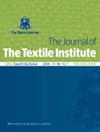采用软计算程序优化聚丙烯腈纳米纤维空气过滤器静电纺丝工艺参数
IF 1.5
4区 工程技术
Q2 MATERIALS SCIENCE, TEXTILES
引用次数: 0
摘要
摘要本研究在此基础上,提出了一种基于人工神经分析模型和遗传算法的纳米纤维过滤器形态特性工程研究新策略。主要思想是在大规模生产之前设计纳米纤维过滤器的形态特性。为了收集数据,采用中心复合实验设计,考虑聚合物浓度(10、12和14 wt%)、施加电压(14、18和22 kV)、距离(10、15和20 cm)和时间(15、30和45 min)等参数。结果表明,当聚合物浓度为10.08 wt%,施加电压为16.09 kV,距离为20 cm,时间为27.17 min时,成本值从0.1477降低到0.1183。优化后的过滤器在粒径为300 nm时,过滤效率为95%,压降为169.2530 Pa。作者贡献:negar Hosseinzadeh Kouchehbaghi和Majid Sohrabi进行了所有实验,Milad Razbin对数据进行了概念化、分析、建模和优化,Ahmad Ahmadi Daryakenari、Marjan Abbasi和Seyed Hajir Bahrami监督、资助和管理了这项研究。在写作和审稿阶段,所有作者都做出了贡献。披露声明作者声明,他们没有已知的竞争经济利益或个人关系,可能会影响本文所报道的工作。数据可用性声明支持本研究结果的所有数据均可应要求从通讯作者处获得。本文章由计算机程序翻译,如有差异,请以英文原文为准。
Soft computing procedure to optimize the electrospinning parameters of polyacrylonitrile nanofibrous air filter
AbstractFollowing the previous work, this research aims to highlight the applicability of a new strategy for engineering morphological properties of nanofibrous filters using a model consisting of artificial neural analytical model, and genetic algorithm. The main idea is to engineer the morphological properties of nanofibrous filters before mass production. To collect data, a central composite design of experiment considering parametersch as polymer concentration (10, 12, and 14 wt%), applied voltage (14, 18, and 22 kV), distance (10, 15, and 20 cm), and time (15, 30, and 45 min) is employed. Results showed that reduced the cost value from 0.1477 to 0.1183 incororating a polymer concentration of 10.08 wt%, an applied voltage of 16.09 kV, a distance of 20 cm, and a time of 27.17 min. The optimized filter possessed a filtration efficiency of 95% and a pressure drop of 169.2530 Pa for a particle size of 300 nm.Keywords: Electrospun nanofibrous filterfeed-forward back-propagationcentral composite design of experimentgenetic algorithmlinear programming Author contributionsNegar Hosseinzadeh Kouchehbaghi and Majid Sohrabi carried out all experimentation, Milad Razbin conceptualized, analyzed, modeled, and optimized data, Ahmad Ahmadi Daryakenari, Marjan Abbasi, and Seyed Hajir Bahrami supervised, funded, and administered the study. In the writing and reviewing step, all authors contributed.Disclosure statementThe authors declare that they have no known competing financial interests or personal relationships that could have appeared to influence the work reported in this paper.Data availability statementAll the data used to support the findings of this study are available from the corresponding author upon request.
求助全文
通过发布文献求助,成功后即可免费获取论文全文。
去求助
来源期刊

Journal of the Textile Institute
工程技术-材料科学:纺织
CiteScore
4.20
自引率
5.90%
发文量
149
审稿时长
1.0 months
期刊介绍:
The Journal of The Textile Institute welcomes papers concerning research and innovation, reflecting the professional interests of the Textile Institute in science, engineering, economics, management and design related to the textile industry and the use of fibres in consumer and engineering applications. Papers may encompass anything in the range of textile activities, from fibre production through textile processes and machines, to the design, marketing and use of products. Papers may also report fundamental theoretical or experimental investigations, including materials science topics in nanotechnology and smart materials, practical or commercial industrial studies and may relate to technical, economic, aesthetic, social or historical aspects of textiles and the textile industry.
All published research articles in The Journal of The Textile Institute have undergone rigorous peer review, based on initial editor screening and anonymized refereeing by two expert referees.
 求助内容:
求助内容: 应助结果提醒方式:
应助结果提醒方式:


